The Ibexes Rock shows one of the most interesting Iron Age hunting scenes (VII-IV cent. BC) of the western Alps. At the same time it hosts the highest alpine Roman inscriptions (I sec. AD). Many similarities with the Camunnian engraved hunting scenes, while here the ibex takes the place of the deer [these notes are taken by the EuroPreArt (European Prehistoric Art) database, short photogallery added].
by EuroPreArt
The Ibexes rock
An interesting record from the EuroPreArt database | online at EuroPreArt
The engraved surface of the Ibexes Rock shows one of the most interesting Iron Age hunting scenes of the western Alps. Il lies at 2240 m of altidude in the French Maurienne valley, in the Moncenisio area. Three ibexes and two hunters, helped by a dog, are depicted. The ibexes are well detailed and the warrior-hunter is depicted while handling a shake and a little shield. In this area the ibex replace the deer in the hunting scenes. The scene shows close similarities (seminaturalistic way of depicting the bodies, curly tail dog, general theme and composition of the hunting scene) with the analogous Camunnian ones of the Iron age, VII-IV cent. BC.
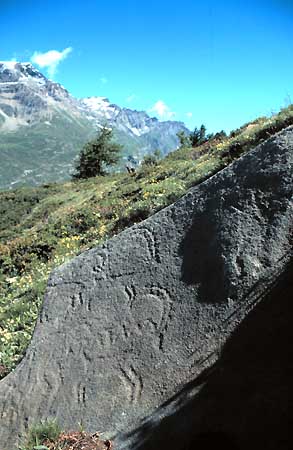
Haute Maurienne, Ibexes Rock, the rock and the environment (photo AA- GRCM 1993)
Over this scene a Roman inscription was carved, the highest Roman found in the Alps and the third of erotic content; it has been read by the epigraphist G. Mennella. It says: “Luccius Mett…. qui amat iatinu(m) or “latinu(m)“, “aratam“, “amat“. The interpretation is that these inscriptions were executed as a graffito, so defacing the more ancient Iron age scene, by a Roman officer controlling the payment of the taxes (quadragesima galliarum) in the Moncenisio pass area. The graffito represent a disgrace against Lucius Mettius, who is described as having inconvenient erotic practices with the ibexes.
So: “Luccius Mettius qui amat platinum” would mean “L.M. who loves ibex”, “aratam” stays for “ploughed” (latu sensu…) and “amat” is “loves”. Obviously the Roman officer didn’t understand anything of the hunting scene, probably ritual-mythological in its origin, and wrote over the rock exactly like a nowadays kid adding a moustache over a Mona Lisa reproduction.
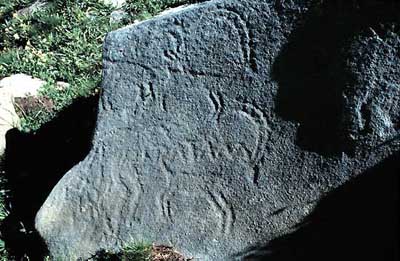
Haute Maurienne, Ibexes Rock, the hunting scene and the Roman writings (photo AA- GRCM 1993)
The rock has been discovered on October 1989 by P. Meirano, G. M. Cametti and Andrea Arcà of the Gruppo Ricerche Cultura Montana (GRCM) of Turin. It has been studied by the French team of the Chambery Archaeological Museum, by the GRCM itself, and by the Prof. G. Mennella of the Genoa University who read the roman inscriptions.
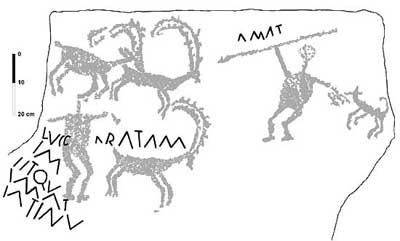
Haute Maurienne, Ibexes Rock, the entire tracing and the Roman writings (tracing GRCM 1991, epigraphic interpretation of G. Mennella)
Figures: 3 ibexes, 1 curly tail dog, 1 hunter with spear, 1 anthropomorphic figure with no head, 3 Roman inscriptions.
Dimensions: length 1.30 m; width 0.70 m, depth 0.35 m. Altitude: 2240 m.
Geology: filladic calcschist (metamorphic rock composed by calcite and mica). This kind of rock allows the pecking technique, but is more affected by the erosion (water and wind) than the Permian sandstone, thus the siliceous component, not soluble in water, is quite resistant. The rock is covered by snow for 6-7 months each year.
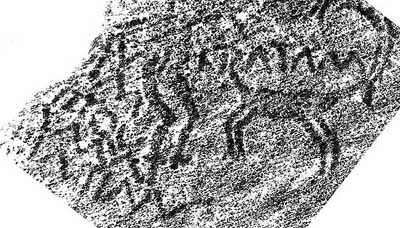
Haute Maurienne, Ibexes Rock, detail of the Roman writings (digital enhancement A. Arcà 1997)
Chronology: the hunting scene (massive body warriors, curly tail dog, semi-naturalistic animals) is clearly comparable with the similar scenes of the Iron Age Valcamonica rock art (IV2-IV3 style, VII-IV cent. BC). The Roman inscriptions are of the I cent. AD.
The rock has been completely recorded (International western Alps rock art record), traced (contact tracing and digital vectorial rendition – GRCM tracing, now in the Footsteps of Man archive), photographed (normal light and grazing light colour slides). A cast has been executed (professional technique with elastomeric mould and copy in synthetic resin) by the Chambery Museum.
More details on the book: GRCM – MiBAC, La spada sulla Roccia, danze e duelli tra arte rupestre e tradizioni popolari della Valsusa, Valcenischia e delle Valli del Moncenisio, a cura di Andrea Arcà – 2009.
The Ibexes Rock, discovery 1989 – 5 slides
(to open the slide show, please click on the first or any thumbnail photo)
No relation with, but the 88% of prehistoric Iran rock art engraved subject, as stated in the www.iranrockart.com site, consists in “symbolic ibex with big curved horn” (Nasseri Fard, M. 2011)
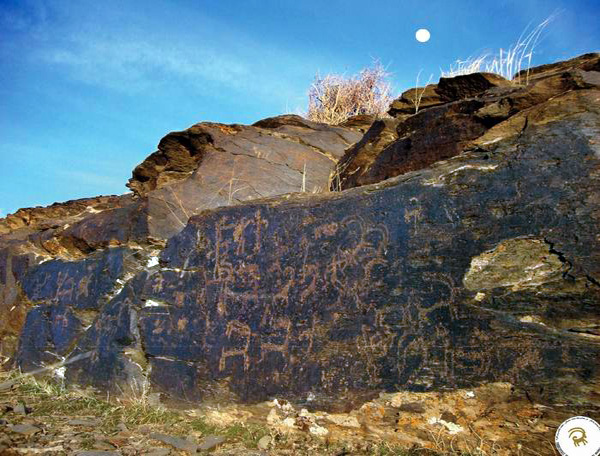
Prehistoric Rock Art in Khomeyn (Iran). Photo By Mohamad Naserifard (click for the original web site)

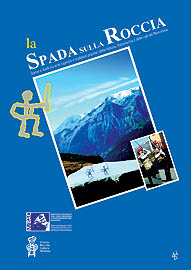





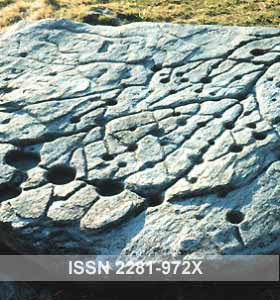













Leave a Reply